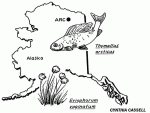The Arctic Tundra LTER conducts its field work on the North Slope of the Brooks Range in Alaska approximately 125 miles south of the Arctic Ocean. Extensive ecosystem research is being conducted on two rivers, 11 lakes and five terrestrial sites. These research sites are now located within an Area of Critical Environmental Concern (ACEC), a designation created recently by the Bureau of Land Management in order to help protect the ongoing long- term research in the Toolik Lake and Kuparuk River areas.
Scaling Up
Two new grants, one through NSF’s Division of Polar Programs for freshwater systems and the other for terrestrial research, will enable the Arctic LTER to expand its research program. The expanded program will include a more detailed study of land-water interactions, as well as a “scaled-up” examination of arctic lakes, streams and tundra. This will assist in the development of ecosystem models at both watershed and regional levels.
Nutrient Enrichment Study
In addition to long-term ecosystem monitoring, the Arctic LTER is engaged in extensive research of top- down (predator) and bottom-up (nutrient) controls in aquatic and terrestrial systems. The studies involve manipulations of both predators and nutrients and, in some cases, have been ongoing for more than eight years. Following is a summary of enrichment studies results to date:
Lakes. A study of lake system responses to added nutrients was begun in 1983. Nitrogen (N) and phosphorus (P) were added, first to limnocorrals, then to the treatment side of a lake divided with a plastic curtain. Lakes and limnocorrals responded to added N and P with an immediate increase in algal growth and biomass. Most zooplankton species doubled their abundance after one-year. It took three to four years of enrichment before decomposition of the increased algal biomass began to deplete the bottom water of its late winter oxygen supply.
The iron rich sediments of the divided lake tightly bound P and, even though bottom waters approached anoxia, no P was released into the water column. Within the sediments some iron-bound P became available to the benthic algae, which responded with an estimated two- to threefold increase in productivity in 1988.
This year the enrichment will be discontinued and an examination of the dynamics of recovery will begin. In addition, nutrient control will be investigated in another, larger lake type, with a different morphology and community structure.
Streams. The Kuparuk River has been fertilized with P since 1983. The sequence of responses measured indicates that the dissolved phosphate stimulated the growth of epilithic algae, which lead to increased sloughing and export of algal biomass. Bacterial activity and biomass also increased. Only by the third year of treatment did insects show enhanced growth rates and, in — some cases, increased densities. As a result of this greater food resource, young-of-the-year and adult grayling grew faster and had better condition factors; only after several years of fertilization did the top predator show response.
This year P enrichment of Oksrukuyik Creek will begin. This stream has a number of characteristics (size, discharge volume, riparian and macrophyte development, and stream bed composition) that differ from the Kuparuk and may alter nutrient uptake dynamics and, consequently, responses to enrichment. The expanded enrichment study will provide the opportunity to investigate how various stream types respond to similar experimental treatments.
Terrestrial. Plots of tussock tundra were fertilized with N and P beginning in 1980. Air temperature and light intensity were also manipulated on experimental plots by placing small greenhouses over the tundra. The greatest responses were seen on the fertilized plots. In the first three years the grasses and sedges responded most rapidly to the fertilization, while deciduous shrubs were able to take advantage of the increased nutrients only when air temperature was also increased. By year nine, the main component of the increased productivity in the fertilized plots was the dramatic increase in the slower-growing deciduous shrubs. Nutrient supply appears to be the primary control over net productivity and eventual composition of the community. Temperature, however, plays a major role in controlling the rate of change in community composition.
In 1989 the study was expanded to include dry heath and wet sedge areas. Results from these studies show that it may take years for ecosystem responses to appear.
Field Database
Communications at the Toolik Lake Station took a great step forward last summer with the addition of a satellite phone system that provides for voice communication as well as a computer link through the University of Alaska. This summer the Arctic LTER database will be available at the Toolik Research Camp, allowing resident scientists to quickly access data.
Contact Bernie Moller, Marine Biological Laboratory Ecosystem Center, Woods Hole, MA 02543, 508-548-3705, or “bMoller@lternet.washington.edu”

 Enlarge this image
Enlarge this image
